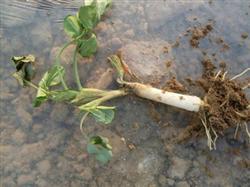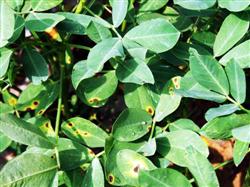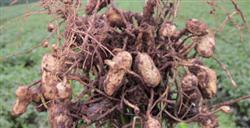How to control peanut stem rot?

How to prevent and cure peanut stem rot? Please introduce peanut stem rot, commonly known as rotten neck disease, which usually occurs in the middle and later stage, wilts and dies soon after infection, and is susceptible in the later stage. Pods often rot or seed dissatisfaction, resulting in serious losses, the general field incidence of 20%-30%, serious cases up to 60%-70%, or even no harvest. First, symptomatic bacteria invade the plant from cotyledons or young roots, produce yellowish-brown watery spots in the root neck, and then turn dark brown, causing root tissue rot. When in a humid environment, the diseased part produces conidia (that is, small black protuberances), the epidermis of the diseased part is easy to peel off and the fibrous tissue is exposed. When the environment is dry, the epidermis of the diseased part is sunken, close to the stem, and after the adult plant is infected, the whole plant dies in about 10-30 days, and the disease site is mostly close to the ground at the base of the stem, and sometimes the main stem and side branches die by stages. Second, the pathogen of the disease mainly overwinters on the diseased and residual plants in the seeds and soil, which will become the source of the disease next year. If the diseased plant as a beverage or pod shell after raising livestock manure, as well as mixed with diseased plants accumulated soil manure can also spread. Transmission in the field mainly depends on Rain Water runoff in the field, followed by strong winds, but germs can also be transmitted in the course of agricultural operations. In rainy and wet years, especially in the harvest season, the bacteria-carrying rate of harvested seeds is higher, so it is not only the main disseminator of the disease, but also can spread over a long distance through introduction. Third, prevention and control methods 1. Prevent the seed from mildew and ensure the seed quality. (1) timely harvest to avoid dampness and mildew of seeds; (2) drying seeds to ensure that the water content does not exceed 10%; (3) safe storage, pay attention to ventilation and moistureproof; (4) do not sow moldy seeds or spoiled seeds; (5) early sowing peanuts with wheat and peanuts have a light incidence; (6) select disease-resistant varieties. two。 Reasonable rotation. It is best to rotate with wheat, sorghum, corn and other gramineous crops. 3. Apply rotten fertilizer. 4. Chemical control. Soak the seeds with 25% or 50% carbendazim wettable powder according to 0.3% 0.5% of the seed weight or 0.5% 0.1% of the seed amount mixed with water, and soak the seeds for 24 hours. Click to get more peanut planting techniques click to get more grain and oil crop planting techniques
- Prev

How to prevent premature senility of peanuts?
How to prevent premature senility of peanuts? Please guide peanuts to prevent premature decline need to do the following: 1, select the site. Select the fields with higher fertility and apply sufficient base fertilizer to plough 25cm and 30cm in advance and dry ridges. Per mu, 2000 kg of rotten ring fertilizer or 25-35 kg of cake fertilizer, 50 kg of ternary compound fertilizer, 50 kg of phosphate fertilizer and zinc fertilizer.
- Next

What are the hazards of peanut continuous cropping?
What are the hazards of peanut continuous cropping? Please introduce the harm of peanut continuous cropping as follows: 1. It causes serious soil deficiency. Because the root of peanut has a large number of rhizobium, it is not very sensitive to nitrogen. Due to continuous cropping, the soil is lack of elements and can not meet the nutrients needed by peanuts, thus affecting the normal growth and development of peanuts. Continuous cropping time.
Related
- The first cup of black tea in spring, the flavor and history of tea gardens in Kenya, Africa
- The computer can not only choose potatoes, but also grow tea rice. AI will grow winter oolong tea champion.
- It is not only the inflated tea bitten by insects, but also engraved with the four seasons tea in Beipu.
- The Oriental Beauty Tea Festival in Zhuxian County takes the stage at the weekend to experience the plus-size feast of oil tea.
- & quot; Oriental Beauty Tea & Exploration of Emei in Hsinchu, the hometown of quot;
- The new variety of strawberry "Tainong 1" dessert is the first choice with mellow aroma. Crimson gorgeous
- History of Tea in Taiwan: from Wild Inner Mountain to Export Tea Garden
- Two types of Taiwan Oriental Beauty Black Tea won the British three-Star Award for Childhood Tea Xiang Zhang Jiaqi changed from pilot to champion tea maker.
- Banana species and varieties: the planting history of Taiwan Xianren banana and dwarf banana is long, is banana disease resistant?
- Coffee planting Technology: Qianjie Coffee from Seedling to harvesting

